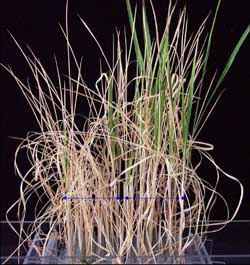
NIL(SKC1) seedlings (R) are more tolerant to salt than Koshihikari (L) under salt stress (125 mM NaCl for 32 days). It indicated that the QTL SKC1 is involved in salt tolerance.

In cooperation with US colleagues, CAS researchers have made significant progress in their studies into functional genes for key agronomic traits by cloning
SKC1, a salt-tolerant functional gene of rice and making clear its biological functions and mechanisms. This pioneering work, which was reported in the Oct. issue of
Nature Genetics (37: 1141-1146), is believed to hold promise to improve the output of the crop plant in this country.
With the population explosion, socio-economic development and the changes in natural conditions, agriculture production is facing challenges from a number of unfavorable factors, such as water shortage, soil salinity and land desertification. To address the problems, stress tolerance, the ability of the crops to tolerate unfavorable environmental conditions such as drought, salt, flooding or cold has become a key research issue in the world.
Stress tolerance is a complex agricultural trait controlled by a combination of genes called the quantitative trait loci (QTL). So, to clone these genes is of vital significance to regulate the genetic mechanism and hence breed the improved variety. Yet, the related genetic mechanism is utterly complicated and to obtain the cloned individuals is very difficult. Although quite a number of labs in the world are engaged in this work but remarkable results are still few, and there is no report on the successful cloning of QTL responsible for stress tolerance.
After many years of hard work and on basis of their previous work on mapping SKC1, the rice QTL that maintains K+ homeostasis in the salt-tolerant variety under salt stress, a research team led by Prof. Lin Hongxuan with the National Key Laboratory of Plant Molecular Genetics at the CAS Shanghai Institute of Plant Physiology & Ecology has been successful in cloning the gene. The SKC1 can effectively controls and balances the content of Na and K elements in the part of rice shoot growing above the ground and prevent excessive poisonous hydronium from accumulating in stem and leaves under salt stress.
Funded by both the central and Shanghai governments, Lin and his 13 researchers and students spent the past five years carrying out the project, which they say is a important achievement in the country's agricultural development.
Functional analysis shows that SKC1 is regulating the long-distance transfer of the ions, and capable of maintaining homeostasis between the K ion and Na ion in the rice's shoot when suppressed by soil salinity. The homeostasis features high content of K ion and low content of Na ion, so that the rice's growth can endure higher content of salinity in the farmland.
In order to further clarify the gene's functions, the research team led by Prof. Lin jointed hands with a group headed by Prof. Luan Sheng from the University of California, Berkeley to conduct the functional analyses of the gene's electric physiology. They discovered the gene's encoding a protein transported Na+ is not responsible for direct transfer of the K ion and the latter's change in its content comes from the competition of Na ion. The protein is located on the surface of the cellular membrane and its bio-activity in a high salt-tolerance variety is stronger than that in a salt-sensitive variety.
On the basis of the discoveries, scientists can speculate the gene's working mechanism as follows: under the salt stress, the above-ground stems and leaves of a rice plant can accumulate a great number of Na ions, which will be forced to come back to the root by that SKC1 functions in the re-circulation of Na+ from shoots to roots. In this way, the toxicity caused by the Na ions may be neutralized and hence the rice is able to endure more salinity in the soil.
The research result is of wide application potential in breeding rice cultivars featuring the salinity tolerance. The Nature Genetics reviewer say that the paper is noted for its rigorous approach of the technology. It will not only be interesting to plant biologists and agronomists, but also sparks interest from biologists in the evolutionary course of the ion-transport system and how it can play a role in a complicated eukaryotic organism.
This discovery could have significance for China's food security because more 8% of its fields have high levels of salt. The work is one of outstanding research results in China's exploration of rice's functional genomics for important agricultural traits, says Prof. Han Bin, director of the CAS-run National Center for Gene Research. "It is of extra-ordinary academic significance and bright prospects in its application of improving rice salt tolerance for coming years."








